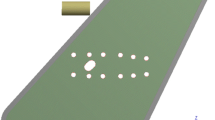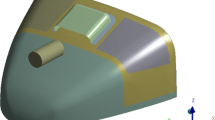Abstract
A novel design of a fibre-reinforced composite Leading Edge (LE) of a Horizontal Tail Plain (HTP) is proposed. The development and validation approach of the innovative composite LE structure are described. The main design goal is the satisfactory impact resistance of the novel composite LE in the case of bird strike. The design concept is based on the absorption of the major portion of the bird kinetic energy by the composite skins, in order to protect the ribs and the inner LE structure from damaging, thus preserving the tail plane functionality for safe landing. To this purpose, the LE skin is fabricated from specially designed composite panels, so called ‘tensor skin’ panels, comprising folded layers, which unfold under the impact load and increase the energy absorption capability of the LE. A numerical model simulating the bird strike process is developed and bird strike experimental testing is performed, in order to validate the proposed layout and prove the capability of the structure to successfully withstand the impact loading. The numerical modelling issues and the critical parameters of the simulation are discussed. The present work is part of the European Aeronautics Research Project, ‘Crashworthiness of aircraft for high velocity impact – CRAHVI’ [1].
Similar content being viewed by others
References
BRITE-EURAM No G4RD-CT-2000-00395, Crashworthiness of Aircraft for High Velocity Impact (CRAHVI), Final Report, CEC, Brussels, 2004.
Michielsen, A., Wiggenraad, J., Ubels, L., Frijns, R., Labeas, G. and McCarthy, M., Design, Test and Analysis of Tensor Skin Panels for Improved Crashworthiness in Case of Water Impact, Proceedings of Crash Safety Challenges and Innovative Solutions, Phoenix, Arizona, Sept. 14–16, 1998.
Dyneema the Top in High Performance: Fibers Properties & Applications, DSM High Performance Fibers B.V., Edition 02/94.
Joint Aviation Authority, JAR-25 Change 14, §25.631 Bird Strike Damage, May 1994.
Federal Aviation Administration, FAR-25, §25.631 Bird Strike Damage, January 1993.
PAM-CRASHTM Solver Notes and Reference, ESI Group, 2002.
Gallard, J. P., Report on Composite Commuter Leading Edge Bird Strike Tests, CRAHVI internal report, CEAT, 2002, p. 7.
Labeas, G. and Kermanidis, Th., ‘Crushing behaviour of the Energy Absorbing ‘Tensor Skin’ panels', Fatigue and Fracture of Engineering Materials and Structures 26, 2003, 449–457.
Ubels, L. C., Johnson, A. F., Gallard, J. P. and Sunaric, M., ‘Design and Testing of a Composite Bird Strike Resistant Leading Edge’, SAMPE Europe: 24th International Conference and Forum, Paris, 1–3 April 2003, pp. 6.
Johnson, A. F., Pentecôte, N., Kraft, H. and Weissinger, H., Measurement of Dyneema/Epoxy Composite Mechanical Properties, CRAHVI internal report, DLR, August 2002, pp. 10–22.
Author information
Authors and Affiliations
Corresponding author
Rights and permissions
About this article
Cite this article
Kermanidis, T., Labeas, G., Sunaric, M. et al. Development and Validation of a Novel Bird Strike Resistant Composite Leading Edge Structure. Appl Compos Mater 12, 327–353 (2005). https://doi.org/10.1007/s10443-005-3441-z
Received:
Accepted:
Issue Date:
DOI: https://doi.org/10.1007/s10443-005-3441-z




